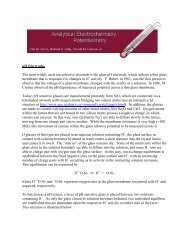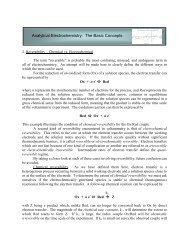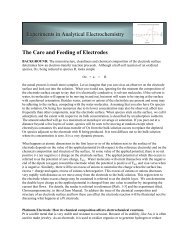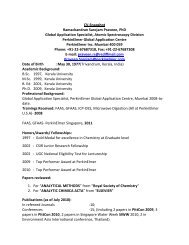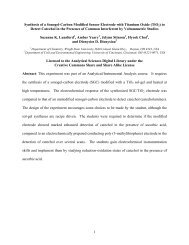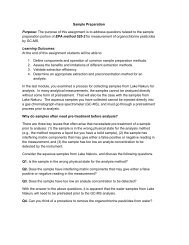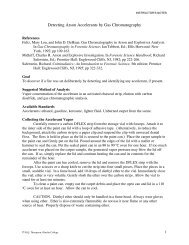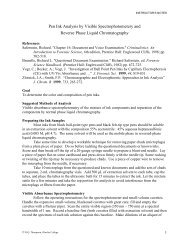5. Analysis of Trace Lead in Water by Anodic Stripping Voltammetry ...
5. Analysis of Trace Lead in Water by Anodic Stripping Voltammetry ...
5. Analysis of Trace Lead in Water by Anodic Stripping Voltammetry ...
You also want an ePaper? Increase the reach of your titles
YUMPU automatically turns print PDFs into web optimized ePapers that Google loves.
11. Repeat the experiment with the background solution and then with all three standard Pbsolutions, runn<strong>in</strong>g duplicates for each concentration. Always remove the Hg film between runs.Next, run duplicates on the unknown water sample.12. Plot the peak heights vs. concentration for the blank and standards and then determ<strong>in</strong>e theamount <strong>of</strong> Pb <strong>in</strong> the tap water from the calibration plot (not<strong>in</strong>g where the peak height <strong>of</strong> thesample lies on the plot <strong>of</strong> the standard solutions).13. Do a l<strong>in</strong>ear regression analysis to confirm the ppb lead <strong>in</strong> the unknown water sample (run atleast duplicates on the standards and the sample if time permits).Note: If you are us<strong>in</strong>g a computer-controlled potentiostat like the CS-1200, the procedure for theanalysis <strong>of</strong> lead is the same as that described above. With this <strong>in</strong>strument, you can and shouldscan at rates as high as 1 or 2 V/s. The tim<strong>in</strong>g and potentials can be set with the computer menubut please remember to turn the stirrer <strong>of</strong>f at the preset time <strong>of</strong> 2 m<strong>in</strong>utes.REPORT ( Data <strong>Analysis</strong> and Discussion):Consult with the laboratory supervisor about the content and format <strong>of</strong> your report for this experiment.Suggestions and questions to consider are as follows:1. Write a short summery <strong>of</strong> what you did <strong>in</strong> this experiment, not<strong>in</strong>g any deviations or substitutions<strong>in</strong> the procedure.2. Show example stripp<strong>in</strong>g voltammograms for Pb at 2 or more concentrations. Plot Ip vs. Pbconcentration (both the uncorrected and corrected for background) and from the plot, determ<strong>in</strong>ethe concentration <strong>of</strong> the Pb <strong>in</strong> the unknown sample. [Note: If you could not detect a peak for Pb<strong>in</strong> your unknown, the amount <strong>of</strong> Pb is most likely below 10 ppb.]3. Were there other metals present <strong>in</strong> the water sample as evidenced <strong>by</strong> other peaks? If yes, howcan you identify the metal or metals?4. If your unknown is tap water, the amount <strong>of</strong> Pb may depend on whether the water was leftstand<strong>in</strong>g <strong>in</strong> the pipes for hours or days, or whether you let the water run for a few m<strong>in</strong>utes beforesampl<strong>in</strong>g. If time permits, you may wish to see whether there is a difference <strong>in</strong> the quantity <strong>of</strong> Pbdepend<strong>in</strong>g on the sampl<strong>in</strong>g time.<strong>5.</strong> If time permits, make a run with 100 ppb without the co-deposition <strong>of</strong> Hg and report what youobserved <strong>in</strong> the way <strong>of</strong> the Pb ASV wave shape and height, and compare it to the result with theHg film.Note: It is important to use high purity water throughout <strong>in</strong> mak<strong>in</strong>g solutions and high purityreagents that are designated as be<strong>in</strong>g free <strong>of</strong> heavy metals. Besides trace amounts <strong>of</strong> Pb <strong>in</strong>reagents, copper is usually the ma<strong>in</strong> contam<strong>in</strong>ant.4



